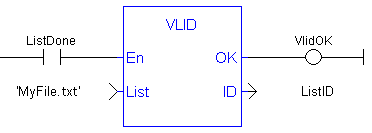
![]() A function calculates a result according to the current value of its inputs. A function has no internal data and is not linked to declared instances. - Create the identifier (ID) of an embedded list of variables
A function calculates a result according to the current value of its inputs. A function has no internal data and is not linked to declared instances. - Create the identifier (ID) of an embedded list of variables
Inputs
FILE : STRING Path name of the .TXT list file - must be a constant value!
Outputs
ID : DINT ID of the list - to be passed to other blocks
Remarks
This function is used to create an Identifier (ID) or ListID for a list of application variables that are typically stored on the development PC. The list of application variables:
- is a simple ".txt" text file.
- can contain only one variable name per line
- can be only global variables
- can only contain single variables. Items of arrays and structures must be specified one by one.
- the length of the list is not limited by the system.
This function's ID output can be used as an input to LogFileCSV. It defines the application variables whose present value will be recorded each time LogFileCSV is executed.
-
-
List files are read at compiling time and are embedded into the downloaded application code. This implies that a modification performed in the list file after downloading will not be taken into account by the application.
ST Language
ListID := VLID ('MyFile.txt');
FBD Language

FFLD Language
(* The function is executed only if EN is TRUE *)







